Java线程总结
在java中要想实现多线程,有两种手段,一种是继续Thread类,另外一种是实现Runable接口。
对于直接继承Thread的类来说,代码大致框架是:
class 类名 extends Thread{
方法1;
方法2;
…
public void run(){
// other code…
}
属性1;
属性2;
…
}
先看一个简单的例子:
class hello extends Thread {
public hello() {
}
public hello(String name) {
this.name = name;
}
public void run() {
for (int i = 0; i < 5; i++) {
System.out.println(name + "运行 " + i);
}
}
public static void main(String[] args) {
hello h1=new hello("A");
hello h2=new hello("B");
h1.run();
h2.run();
}
private String name;
}
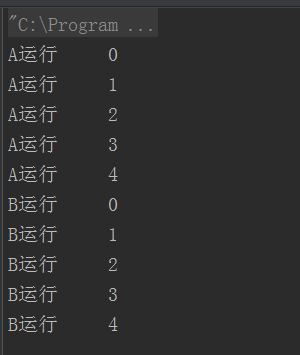
我们会发现这些都是顺序执行的,说明我们的调用方法不对,应该调用的是start()方法。当我们把上面的主函数修改为如下所示的时候:
public static void main(String[] args) {
hello h1=new hello("A");
hello h2=new hello("B");
h1.start();
h2.start();
}

因为需要用到CPU的资源,所以每次的运行结果基本是都不一样的。
注意:虽然我们在这里调用的是start()方法,但是实际上调用的还是run()方法的主体。
那么:为什么我们不能直接调用run()方法呢?
我的理解是:线程的运行需要本地操作系统的支持。
如果你查看start的源代码的时候,会发现:
public synchronized void start() {
/**
* This method is not invoked for the main method thread or "system"
* group threads created/set up by the VM. Any new functionality added
* to this method in the future may have to also be added to the VM.
*
* A zero status value corresponds to state "NEW".
*/
if (threadStatus != 0 || this != me)
throw new IllegalThreadStateException();
group.add(this);
start0();
if (stopBeforeStart) {
stop0(throwableFromStop);
}
}
private native void start0();
注意最后一条语句,说明此处调用的是start0()。并且这个这个方法用了native关键字,次关键字表示调用本地操作系统的函数。因为多线程的实现需要本地操作系统的支持。但是start方法重复调用的话,会出现java.lang.IllegalThreadStateException异常。
通过实现Runnable接口
大致框架是:
class 类名 implements Runnable{
方法1;
方法2;
…
public void run(){
// other code…
}
属性1;
属性2;
…
}
来先看一个小例子吧:
class hello implements Runnable {
public hello() {
}
public hello(String name) {
this.name = name;
}
public void run() {
for (int i = 0; i < 5; i++) {
System.out.println(name + "运行 " + i);
}
}
public static void main(String[] args) {
hello h1=new hello("线程A");
Thread demo= new Thread(h1);
hello h2=new hello("线程B");
Thread demo1=new Thread(h2);
demo.start();
demo1.start();
}
private String name;
}
关于选择继承Thread还是实现Runnable接口?
其实Thread也是实现Runnable接口的:
class Thread implements Runnable {
//…
public void run() {
if (target != null) {
target.run();
}
}
}
Thread和Runnable的区别:
如果一个类继承Thread,则不适合资源共享。但是如果实现了Runable接口的话,则很容易的实现资源共享。
class hello extends Thread {
public void run() {
for (int i = 0; i < 7; i++) {
if (count > 0) {
System.out.println("count= " + count--);
}
}
}
public static void main(String[] args) {
hello h1 = new hello();
hello h2 = new hello();
hello h3 = new hello();
h1.start();
h2.start();
h3.start();
}
private int count = 5;
}
大家可以想象,如果这个是一个买票系统的话,如果count表示的是车票的数量的话,说明并没有实现资源的共享。
我们换为Runnable接口
class MyThread implements Runnable{
private int ticket = 5; //5张票
public void run() {
for (int i=0; i<=20; i++) {
if (this.ticket > 0) {
System.out.println(Thread.currentThread().getName()+ "正在卖票"+this.ticket--);
}
}
}
}
public class lzwCode {
public static void main(String [] args) {
MyThread my = new MyThread();
new Thread(my, "1号窗口").start();
new Thread(my, "2号窗口").start();
new Thread(my, "3号窗口").start();
}
}
总结一下吧:
实现Runnable接口比继承Thread类所具有的优势:
1):适合多个相同的程序代码的线程去处理同一个资源
2):可以避免java中的单继承的限制
3):增加程序的健壮性,代码可以被多个线程共享,代码和数据独立。
所以,本人建议大家劲量实现接口。
线程的名称:
class hello implements Runnable {
public void run() {
for (int i = 0; i < 3; i++) {
System.out.println(Thread.currentThread().getName());
}
}
public static void main(String[] args) {
hello he = new hello();
new Thread(he,"A").start();
new Thread(he,"B").start();
new Thread(he).start();
}
}
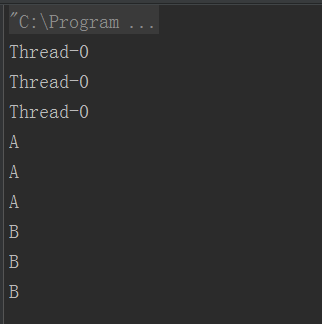
说明如果我们没有指定名字的话,系统自动提供名字。
提醒一下大家:main方法其实也是一个线程。在java中所以的线程都是同时启动的,至于什么时候,哪个先执行,完全看谁先得到CPU的资源。
在java中,每次程序运行至少启动2个线程。一个是main线程,一个是垃圾收集线程。因为每当使用java命令执行一个类的时候,实际上都会启动一个JVM,每一个JVM实际在就是在操作系统中启动了一个进程。
判断线程是否启动
package demos;
public class hello implements Runnable {
public void run() {
for (int i = 0; i < 3; i++) {
System.out.println(Thread.currentThread().getName());
}
} public static void main(String[] args) {
hello he = new hello();
Thread demo = new Thread(he);
System.out.println("线程启动之前---》" + demo.isAlive());
demo.start();
System.out.println("线程启动之后---》" + demo.isAlive());
}
}
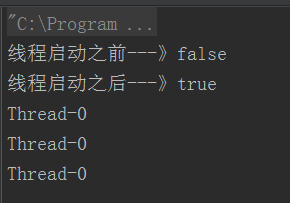
主线程也有可能在子线程结束之前结束。并且子线程不受影响,不会因为主线程的结束而结束。
线程的强制执行:
package demos;
public class hello implements Runnable {
public void run() {
for (int i = 0; i < 3; i++) {
System.out.println(Thread.currentThread().getName());
}
} public static void main(String[] args) {
hello he = new hello();
Thread demo = new Thread(he, "线程");
demo.start();
for(int i=0;i<50;++i){
if (i > 10) {
try{
demo.join(); //强制执行demo
}catch (Exception e) {
e.printStackTrace();
}
}
System.out.println("main 线程执行-->"+i);
}
}
}
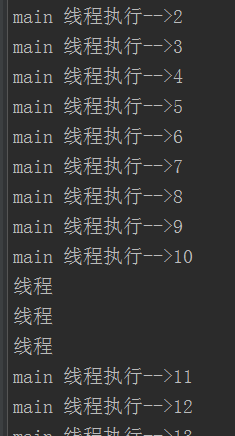
线程的休眠:
package demos;
public class hello implements Runnable {
public void run() {
for (int i = 0; i < 3; i++) {
try {
Thread.sleep(2000);
} catch (Exception e) {
e.printStackTrace();
}
System.out.println(Thread.currentThread().getName() + i);
}
} public static void main(String[] args) {
hello he = new hello();
Thread demo = new Thread(he, "线程");
demo.start();
}
}
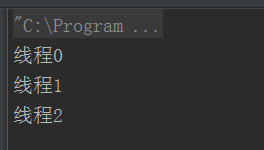
线程中断:
package demos;
public class hello implements Runnable {
public void run() {
System.out.println("执行run方法");
try {
Thread.sleep(10000);
System.out.println("线程完成休眠");
} catch (Exception e) {
System.out.println("休眠被打断");
return; //返回到程序的调用处
}
System.out.println("线程正常终止");
} public static void main(String[] args) {
hello he = new hello();
Thread demo = new Thread(he, "线程");
demo.start();
try{
Thread.sleep(2000);
}catch (Exception e) {
e.printStackTrace();
}
demo.interrupt(); //2s后中断线程
}
}

在java程序中,只要前台有一个线程在运行,整个java程序进程不会消失,所以此时可以设置一个后台线程,这样即使java进程消失了,此后台线程依然能够继续运行。
package demos;
public class hello implements Runnable {
public void run() {
while (true) {
System.out.println(Thread.currentThread().getName() + "在运行");
}
} public static void main(String[] args) {
hello he = new hello();
Thread demo = new Thread(he, "线程");
demo.setDaemon(true);
demo.start();
}
}
虽然有一个死循环,但是程序还是可以执行完的。因为在死循环中的线程操作已经设置为后台运行了。
线程的优先级:
package demos;
public class hello implements Runnable {
public void run() {
for(int i=0;i<5;++i){
System.out.println(Thread.currentThread().getName()+"运行"+i);
}
}
public static void main(String[] args) {
Thread h1=new Thread(new hello(),"A");
Thread h2=new Thread(new hello(),"B");
Thread h3=new Thread(new hello(),"C");
h1.setPriority(8);
h2.setPriority(2);
h3.setPriority(6);
h1.start();
h2.start();
h3.start();
}
}
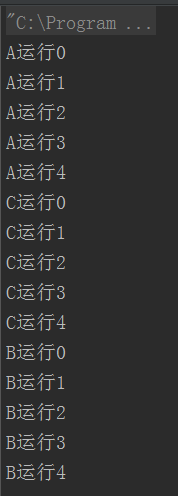
但是不要误以为优先级越高就先执行。谁先执行还是取决于谁先取得CPU的资源。另外,主线程的优先级是5.
线程的礼让:
在线程操作中,也可以使用yield()方法,将一个线程的操作暂时交给其他线程执行。
package demos;
public class hello implements Runnable {
public void run() {
for(int i=0;i<5;++i){
System.out.println(Thread.currentThread().getName()+"运行"+i);
if(i==3){
System.out.println("线程的礼让");
Thread.currentThread().yield();
}
}
}
public static void main(String[] args) {
Thread h1=new Thread(new hello(),"A");
Thread h2=new Thread(new hello(),"B");
h1.start();
h2.start();
}
}

同步和死锁:
package demos;
public class hello implements Runnable {
public void run() {
for(int i=0;i<10;++i){
if(count>0){
try{
Thread.sleep(1000);
}catch(InterruptedException e){
e.printStackTrace();
}
System.out.println(count--);
}
}
} public static void main(String[] args) {
hello he=new hello();
Thread h1=new Thread(he);
Thread h2=new Thread(he);
Thread h3=new Thread(he);
h1.start();
h2.start();
h3.start();
}
private int count=5;
}
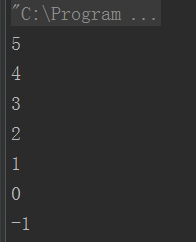
这里出现了-1,显然这个是错的。,应该票数不能为负值。
如果想解决这种问题,就需要使用同步。所谓同步就是在统一时间段中只有有一个线程运行,
其他的线程必须等到这个线程结束之后才能继续执行。
【同步代码块】:
语法格式:
synchronized(同步对象){
//需要同步的代码
}
但是一般都把当前对象this作为同步对象。
比如对于上面的买票的问题,如下:
package demos;
public class hello implements Runnable {
public void run() {
for(int i=0;i<10;++i){
synchronized (this) {
if(count>0){
try{
Thread.sleep(1000);
}catch(InterruptedException e){
e.printStackTrace();
}
System.out.println(count--);
}
}
}
} public static void main(String[] args) {
hello he=new hello();
Thread h1=new Thread(he);
Thread h2=new Thread(he);
Thread h3=new Thread(he);
h1.start();
h2.start();
h3.start();
}
private int count=5;
}

也可以采用同步方法。
语法格式为synchronized 方法返回类型方法名(参数列表){
// 其他代码
}
现在,我们采用同步方法解决上面的问题。
class hello implements Runnable {
public void run() {
for (int i = 0; i < 10; ++i) {
sale();
}
}
public synchronized void sale() {
if (count > 0) {
try {
Thread.sleep(1000);
} catch (InterruptedException e) {
e.printStackTrace();
}
System.out.println(count--);
}
}
public static void main(String[] args) {
hello he = new hello();
Thread h1 = new Thread(he);
Thread h2 = new Thread(he);
Thread h3 = new Thread(he);
h1.start();
h2.start();
h3.start();
}
private int count = 5;
}
提醒一下,当多个线程共享一个资源的时候需要进行同步,但是过多的同步可能导致死锁。
此处列举经典的生产者和消费者问题。
【生产者和消费者问题】
先看一段有问题的代码。
package demos;
class Info { public String getName() {
return name;
} public void setName(String name) {
this.name = name;
} public int getAge() {
return age;
} public void setAge(int age) {
this.age = age;
} private String name = "Rollen";
private int age = 20;
} /**
* 生产者
* */
class Producer implements Runnable{
private Info info=null;
Producer(Info info){
this.info=info;
} public void run(){
boolean flag=false;
for(int i=0;i<25;++i){
if(flag){
this.info.setName("Rollen");
try{
Thread.sleep(100);
}catch (Exception e) {
e.printStackTrace();
}
this.info.setAge(20);
flag=false;
}else{
this.info.setName("chunGe");
try{
Thread.sleep(100);
}catch (Exception e) {
e.printStackTrace();
}
this.info.setAge(100);
flag=true;
}
}
}
}
/**
* 消费者类
* */
class Consumer implements Runnable{
private Info info=null;
public Consumer(Info info){
this.info=info;
} public void run(){
for(int i=0;i<25;++i){
try{
Thread.sleep(100);
}catch (Exception e) {
e.printStackTrace();
}
System.out.println(this.info.getName()+"<---->"+this.info.getAge());
}
}
} /**
* 测试类
* */
public class hello{
public static void main(String[] args) {
Info info=new Info();
Producer pro=new Producer(info);
Consumer con=new Consumer(info);
new Thread(pro).start();
new Thread(con).start();
}
}
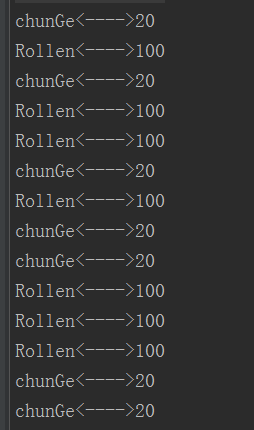
大家可以从结果中看到,名字和年龄并没有对应。
那么如何解决呢?
1)加入同步
2)加入等待和唤醒
先来看看加入同步会是如何:
class Info {
public String getName() {
return name;
}
public void setName(String name) {
this.name = name;
}
public int getAge() {
return age;
}
public void setAge(int age) {
this.age = age;
}
public synchronized void set(String name, int age){
this.name=name;
try{
Thread.sleep(100);
}catch (Exception e) {
e.printStackTrace();
}
this.age=age;
}
public synchronized void get(){
try{
Thread.sleep(100);
}catch (Exception e) {
e.printStackTrace();
}
System.out.println(this.getName()+"<===>"+this.getAge());
}
private String name = "Rollen";
private int age = 20;
}
/**
* 生产者
* */
class Producer implements Runnable {
private Info info = null;
Producer(Info info) {
this.info = info;
}
public void run() {
boolean flag = false;
for (int i = 0; i < 25; ++i) {
if (flag) {
this.info.set("Rollen", 20);
flag = false;
} else {
this.info.set("ChunGe", 100);
flag = true;
}
}
}
}
/**
* 消费者类
* */
class Consumer implements Runnable {
private Info info = null;
public Consumer(Info info) {
this.info = info;
}
public void run() {
for (int i = 0; i < 25; ++i) {
try {
Thread.sleep(100);
} catch (Exception e) {
e.printStackTrace();
}
this.info.get();
}
}
}
/**
* 测试类
* */
class hello {
public static void main(String[] args) {
Info info = new Info();
Producer pro = new Producer(info);
Consumer con = new Consumer(info);
new Thread(pro).start();
new Thread(con).start();
}
}
这样问题就解决了,所有的年龄和名字都正确对应了起来。
但是还是出现了重复读取的问题,也肯定有重复覆盖的问题。如果想解决这个问题,就需要使用Object类帮忙了、,我们可以使用其中的等待和唤醒操作。
要完成上面的功能,我们只需要修改Info类饥渴,在其中加上标志位,并且通过判断标志位完成等待和唤醒的操作,代码如下:
class Info {
public String getName() {
return name;
}
public void setName(String name) {
this.name = name;
}
public int getAge() {
return age;
}
public void setAge(int age) {
this.age = age;
}
public synchronized void set(String name, int age){
if(!flag){
try{
super.wait();
}catch (Exception e) {
e.printStackTrace();
}
}
this.name=name;
try{
Thread.sleep(100);
}catch (Exception e) {
e.printStackTrace();
}
this.age=age;
flag=false;
super.notify();
}
public synchronized void get(){
if(flag){
try{
super.wait();
}catch (Exception e) {
e.printStackTrace();
}
}
try{
Thread.sleep(100);
}catch (Exception e) {
e.printStackTrace();
}
System.out.println(this.getName()+"<===>"+this.getAge());
flag=true;
super.notify();
}
private String name = "Rollen";
private int age = 20;
private boolean flag=false;
}
/**
* 生产者
* */
class Producer implements Runnable {
private Info info = null;
Producer(Info info) {
this.info = info;
}
public void run() {
boolean flag = false;
for (int i = 0; i < 25; ++i) {
if (flag) {
this.info.set("Rollen", 20);
flag = false;
} else {
this.info.set("ChunGe", 100);
flag = true;
}
}
}
}
/**
* 消费者类
* */
class Consumer implements Runnable {
private Info info = null;
public Consumer(Info info) {
this.info = info;
}
public void run() {
for (int i = 0; i < 25; ++i) {
try {
Thread.sleep(100);
} catch (Exception e) {
e.printStackTrace();
}
this.info.get();
}
}
}
/**
* 测试类
* */
class hello {
public static void main(String[] args) {
Info info = new Info();
Producer pro = new Producer(info);
Consumer con = new Consumer(info);
new Thread(pro).start();
new Thread(con).start();
}
}
Java线程总结的更多相关文章
- Java线程并发:知识点
Java线程并发:知识点 发布:一个对象是使它能够被当前范围之外的代码所引用: 常见形式:将对象的的引用存储到公共静态域:非私有方法中返回引用:发布内部类实例,包含引用. 逃逸:在对象尚未准备 ...
- Java线程的概念
1. 计算机系统 使用高速缓存来作为内存与处理器之间的缓冲,将运算需要用到的数据复制到缓存中,让计算能快速进行:当运算结束后再从缓存同步回内存之中,这样处理器就无需等待缓慢的内存读写了. 缓 ...
- Java 线程池框架核心代码分析--转
原文地址:http://www.codeceo.com/article/java-thread-pool-kernal.html 前言 多线程编程中,为每个任务分配一个线程是不现实的,线程创建的开销和 ...
- 细说进程五种状态的生老病死——双胞胎兄弟Java线程
java线程的五种状态其实要真正高清,只需要明白计算机操作系统中进程的知识,原理都是相同的. 系统根据PCB结构中的状态值控制进程. 单CPU系统中,任一时刻处于执行状态的进程只有一个. 进程的五种状 ...
- 【转载】 Java线程面试题 Top 50
Java线程面试题 Top 50 不管你是新程序员还是老手,你一定在面试中遇到过有关线程的问题.Java语言一个重要的特点就是内置了对并发的支持,让Java大受企业和程序员 的欢迎.大多数待遇丰厚的J ...
- 第24章 java线程(3)-线程的生命周期
java线程(3)-线程的生命周期 1.两种生命周期流转图 ** 生命周期:**一个事物冲从出生的那一刻开始到最终死亡中间的过程 在事物的漫长的生命周期过程中,总会经历不同的状态(婴儿状态/青少年状态 ...
- 第23章 java线程通信——生产者/消费者模型案例
第23章 java线程通信--生产者/消费者模型案例 1.案例: package com.rocco; /** * 生产者消费者问题,涉及到几个类 * 第一,这个问题本身就是一个类,即主类 * 第二, ...
- 第22章 java线程(2)-线程同步
java线程(2)-线程同步 本节主要是在前面吃苹果的基础上发现问题,然后提出三种解决方式 1.线程不安全问题 什么叫线程不安全呢 即当多线程并发访问同一个资源对象的时候,可能出现不安全的问题 对于前 ...
- 第21章 java线程(1)-线程初步
java线程(1)-线程初步 1.并行和并发 并行和并发是即相似又有区别: 并行:指两个或者多个事件在同一时刻点发生. 并发:指两个或多个事件在同一时间段内发生 在操作系统中,并发性是指在一段事件内宏 ...
- [转]Java线程安全总结
最近想将java基础的一些东西都整理整理,写下来,这是对知识的总结,也是一种乐趣.已经拟好了提纲,大概分为这几个主题: java线程安全,java垃圾收集,java并发包详细介绍,java profi ...
随机推荐
- Oracle EBS 术语解释
SRS:是否在标准窗口进行提交请求 fnd_flex_value_sets.validation_type含义如下: D:从属I:独立N:无P:对U:特定F:表X:可转换独立Y:可转换从属
- java调用Http请求 -HttpURLConnection学习
最常用的Http请求无非是get和post,get请求可以获取静态页面,也可以把参数放在URL字串后面,传递给servlet,post与get的不同之处在于post的参数不是放在URL字串里面,而是放 ...
- magento url rewrite using config.xml
magento url rewrite using config.xml 2012-08-03 14:34:22| 分类: magento|举报|字号 订阅 郁闷了两天啊 http://12 ...
- 【Android Studio快捷键】之导入相应包声明(import packages)
可能import 单个声明的快捷键大家都很容易找到,Alt+Enter.但是如果我要一次性import文件中所有的声明,这个快捷键是什么呢,找啊找的,就是没找到,以前在Eclipse是Ctrl+1,但 ...
- 配置maven环境
第一步:安装maven,安装maven最简单,直接将maven的解压文件放入本地某目录下即可,无需手动安装 第二步:eclipse中导入maven项目后,会后错,或maven无法使用,则需要进行mav ...
- LeetCode Shortest Word Distance III
原题链接在这里:https://leetcode.com/problems/shortest-word-distance-iii/ 题目: This is a follow up of Shortes ...
- 为什么一个object_id在dba_objects中为什么查不到记录?
SQL> drop table test purge;SQL> create table test (id int,comments CLOB); SQL> select INDEX ...
- js的语句
1.语句类型总结 var box = 100;//单行语句 { //用花括号包含的语句集合,叫做复合语句,单位一个 //一对花括号,表示一个复合语句,处理时,可以单做一条单行语句, //复合语句,我们 ...
- 第十五篇 Integration Services:SSIS参数
本篇文章是Integration Services系列的第十五篇,详细内容请参考原文. 简介在前一篇,我们使用SSDT-BI将第一个SSIS项目My_First_SSIS_Project升级/转换到S ...
- HBase shell
进入命令行 ./hbase shell 查看HBase shell帮助 help 查看命令帮助 直接输入命令回撤 创建命名空间 create_namespace 'ns1' 查看命名空间 list_n ...
